THERE IS AN UPDATED VERSION OF THIS ARTICLE FOR FEBRUARY 2022 USING HANDBRAKE VERSION 1.5.1 HERE
This is a simple easy guide on how to make the best encodes with the smallest file size in Handbrake without having to know or understand all of the settings. Just copy my settings and you’re done!
**NOTE** – These settings are for DVD Video ONLY – You can find a Blu Ray Tutorial HERE.
Video encoding is a topic a lot of people are very passionate about. Factors like TV size, Viewing distance, hardware, drive space restrictions and a plethora of other concerns are all valid. But if you are like me, and just want to reduce your episodes to a more manageable size, whilst retaining most of the quality, here’s how to do it.
PLEASE NOTE – This method will produce very nice quality videos, that will look good on 1080p TV’s, but may take 2 hours or more to process each hour of video, so my advice is to let it run whilst you are sleeping each night.
Once you have ripped your Disks to MKV files with Make MKV, Open Handbrake (You can download the latest version for free HERE) then press the source button and select the file you want to convert, or if you want to do a batch of files, select the folder that contains all of your ripped MKV’s. Handbrake will import them all, but you will only see the first one. Now it’s time to make some adjustments to the settings.
All of your settings should look like the above screen grab – Click it to enlarge.
1. Set the output format to MKV File
2. Click the button that says “Video”. Make sure the video codec is H.264 (x264)
3. The frame rate should be “Same as Source” and Constant Framerate should be selected.
4. Check Constant Quality and adjust the slider until the RF number goes to 20
5. For the encoder options, slide the preset slider to Very Slow. Trust me, it takes a while, but the quality is far superior, and usually yields a smaller file size. Unfortunately it is a trade off for speed vs quality. Like I said, run it while you are sleeping.
6. Leave “Fast Decode” unchecked.
7. Set Tune to Film
8. Set Profile to High
9. Set Level to 3.1
10. Now click the “Picture Settings” button in the top right side of the window.
![]() A new window will open. Change all of your settings look like this
A new window will open. Change all of your settings look like this
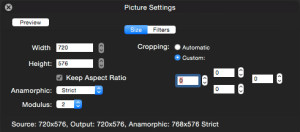 11. Whilst in the picture settings window, click “Filters” and change all of your settings to look like these as well. Denoise and Deblock will make the picture look SO much better when viewed on larger 1080p TVs.
11. Whilst in the picture settings window, click “Filters” and change all of your settings to look like these as well. Denoise and Deblock will make the picture look SO much better when viewed on larger 1080p TVs.
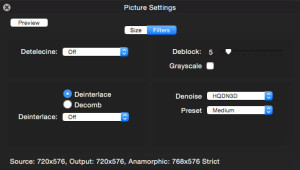 **If you are in the USA you can skip this step, but for the rest of us, we need to know if our video is progressive or interlaced (the method used to draw each frame of video)**
**If you are in the USA you can skip this step, but for the rest of us, we need to know if our video is progressive or interlaced (the method used to draw each frame of video)**
If your video is progressive, you can skip this step, but if it is interlace, you will definitely want to de-interlace the video before you watch it on a 1080 screen, otherwise you will see all kinds of ugly horizontal lines in fast moving scenes like the image below.
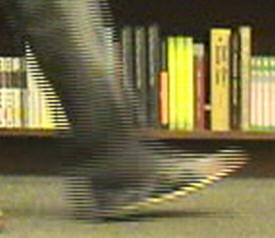 (If you dont know whether your video is interlaced or progressive, Mac users can use Video Spec to find out, and Windows users can use G-Spot to find out)
(If you dont know whether your video is interlaced or progressive, Mac users can use Video Spec to find out, and Windows users can use G-Spot to find out)
If your video is interlaced, make sure “Deinterlace” is checked and select “Slower” for best results.
12. Now you can close out the Picture Settings window and select the “Audio” tab in the main window.
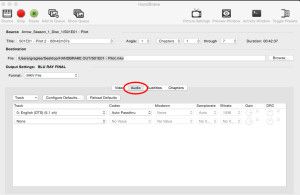 I am a real Audiofile, I love the Dolby Digital and DTS 5-7 channel audio tracks in movies, so I select “Auto PassThru”. But, if regular 2 channel Stereo is ok for you, you can configure that in this area if you want. I figure you are converting a DVD, so you might as well have the best sound quality available. Just select the Dolby Digital or DTS sound track from the drop down window, and choose “Auto Passthru”
I am a real Audiofile, I love the Dolby Digital and DTS 5-7 channel audio tracks in movies, so I select “Auto PassThru”. But, if regular 2 channel Stereo is ok for you, you can configure that in this area if you want. I figure you are converting a DVD, so you might as well have the best sound quality available. Just select the Dolby Digital or DTS sound track from the drop down window, and choose “Auto Passthru”
13. Click the “Subtitles” tab and select none
14. Click the “Chapters” tab and make sure “Create Chapter Markers” is un-checked.
15. You are now ready to start encoding. If you are only doing one file, just press the “Start” button and Handbrake will start encoding. If you are doing a batch of files, open the File Menu and select “Add All Titles To Queue”
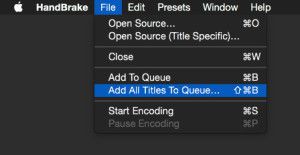 16. Press the “Show Queue” button to see all your files waiting to be encoded
16. Press the “Show Queue” button to see all your files waiting to be encoded
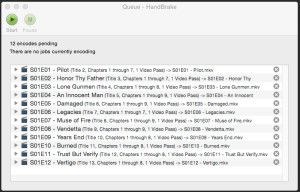 17. Press the “Start” button and your encoding session will begin.
17. Press the “Start” button and your encoding session will begin.
THERE IS AN UPDATED VERSION OF THIS ARTICLE FOR FEBRUARY 2022 USING HANDBRAKE VERSION 1.5.1 HERE


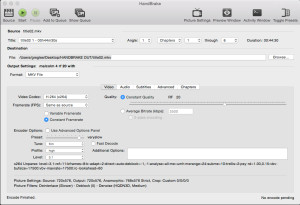
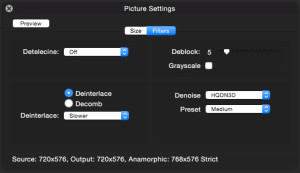
How can I resize a MKV file to a dual layer DVD size(8100 mb)? The old version had “target size) but this version only has a quality bar/presets.
Thanx in advance.
Each DVD seems to have a different size, but your settings indicate 720×576. Do I just set mine to the imported width and height? Also, why do you set the crop to zero and then just add that value to the width and height? Lastly, why do you use 3.1 instead of 4.1 like you use in blu ray video settings.
Some settings for Deinterlace is different in latest version 1.0.3. The picture settings also cannot be modified much. Any chance you could update your instructions for the highest quality AV? 🙂
I’m new to all of this and I might be able to glean something from this. But yes, the new version does not allow for some of the options you’ve shown here. Can you please update? Thanks, Ted
Thank you very much for experimenting and sharing your workflow! I encoded 12 hours of front-talk-class to 3 chunks, 1-2 GB each, still looks pretty good.
How do you proceed? Whenever I want to burn the DVD (creating the Video / Audio TS-folders), it becomes much larger AND gets nasty. Why is that? I was using Free DVD Creator for Mac, 5 Mbit preset. Do you recommend any specific DVD-Burn Programm or certain settings to maintain the quality of the .mkv files?
Thanks a lot!
Hello this article has helped me a lot in the past. The best Handbrake tutorial out there.
However some of the images are unvailable, could you please put them available again?. This time i will print this out just to have it
Hi Angelo, Thanks for your message – I recently move the site to a new server and wasn’t aware that some of the images hadn’t copied accross. Thanks for the heads up. I will get it sorted ASAP so check back in a few days, and the article will be ready for printing. Happy Holidays! Greg
Really useful article but any chance of updating some of the screenshot / settings to align with the current Handbrake version? For example the sizing options are a bit confusing around anamorphic. Should the size always match the size of the source (which often it doesn’t) and should anamorphic be set to automatic as strict is no longer an option?
Many thanks
@Greg what version of handbrake do you recommend? the latest seems to be missing some settings from your tutorial. also is VidCoder a good alternate in your opinion?
Thanks!
Hi Abe, thanks for your comment. The version of Handbrake I recommend is the current one. I have been playing with it today as I have had a lot of requests for an updated version of this article, and I have been blown away by how much work has been done refining the H264 codec since I first wrote this tutorial. I started out with a 30gb BluRay file and got it down to 3gb, yet still retaining the full Dolby Digital 5.1 soundtrack at 640kb, with negligible video quality degridation playing on a 65” 4k tv. I will be posting a new article soon showing how I did it, and at some point in the future I will tackle H265 to see how far I can rzeally take things. I have not tried Vidcoder, so I cant comment either way. I have added to my list of apps to check out, and am looking forward to seeing what it can do.
I’ve been using handbrake for DADs always putting out 720 x 480 – anybody know how to upscale to 1280 x 720 using the Presetes or how to change them
Hi Chris, just found this in the Handbrake documentation:
I am working on a article about how to clean up poor quality video using filters, which may improve your playback. Hopefully will have it finished soon so keep watching this space.
Greg
Hi Greg. thanks for all your work 🙂 – question will we get a new manual? since Handbrake has changed a lot with the current version and new functions have been added. Thanks for the feedabck
Hello, I am trying to convert MPEG-4 video files to MPEG-2, with the goal of burning DVDs from the footage using my VIDBOX software. VIDBOX is very picky and only accepts correctly configured MPEG-2 files. I have what I presume to be the latest version of Handbrake (version 1.9.0 (2024120100). I’ve gone round and round for days trying to figure this out with no success. What steps would you recommend I follow? Thank you.
Hi, I’ve never tried VIDBOX so I am unable to offer any help. I’ve had good success with Roxio Toast and Nero in years gone by, but I must admit it’s been a good 15 plus years since I’ve tried to burn a DVD. Sorry I can’t be of more assistance.